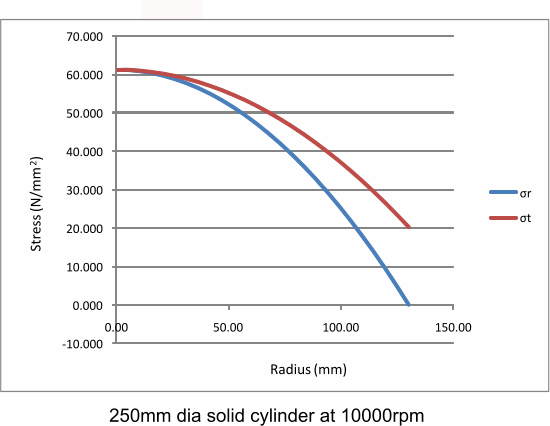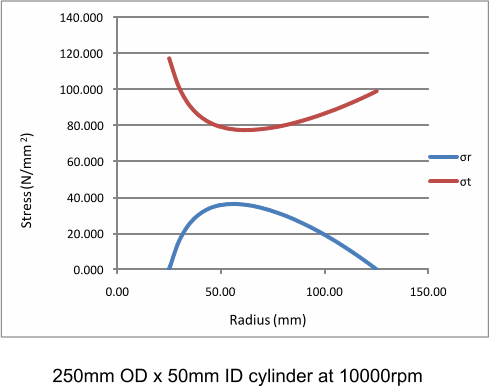These notes relate to the stresses and strains existing in thick walled
cylinders when rotated at speed they are generally applicable to design of flywheels.
The primary assumption is that the cylinders are not subject to internal or external prssure.
A basic review of solid disks, rings and cylinders is carried out.
Tensile stresses are considered positive and compressive stresses are negative.
Eq. 4)........(σ t - σ r ). ( 1 + υ )
+ r.(dσ t/ dr ) ) - υ.r.(dσ r / dr) = 0
Now considering the radial equilibrium of the element of the section. Forces based on unit length of cylinder
2.σ t. δ r.sin(1/2.δθ) +
σrδθ - (σ r +
δσ r) (r + σ r )θδθ =
ρr2 ω2δr δθ
Subtract equation 5...
2.σ r + r.dσ r/dr
= - ρr2ω 2(3+υ)/2 + 2A
2) Cylinders
The primary difference between a long rotating cylinder and a thin one is that it the axial stress σ a is
not equal to 0. The assumption in this case is that the longitudonal strain ε a is constant: cross sections remain plane.
Basis of equations... Refer to introductory notes at the top of webpage
σ r is equivalent to σ 1...
σ t is equivalent to σ 2...
σ a is equivalent to σ 3...
derived equations
Eq. 1)......E ε a = σ a - υσ t - υσ r
Eq. 2)......E.ε t = E.u/r = σ t - υσ a - υσ r
Eq. 3)......E.εr = E.du/dr = σ r - υσ t - υσ a
Multiplying 2) x r
Eu = r ( σ t - υσ a - υσ r )
differentiating
Edu/dr = σ t - υσ a - υσ r +
r. [ dσ t /dr - υ.( dσ a / dr ) - υ.( dσ r / dr ) ]
= σ r - υσ t - υσ a ..( from 3 above )
Simplifying by collecting terms.
Eq. 4)........(σ t - σ r ). ( 1 + υ ) + r.(dσ t/ dr ) - υ.r.(dσ a / dr ) - υ.r.(dσ r / dr) = 0
Now from 1) above since ε a is constant then dσ a /dr = υ (dσ t/dr + dσ r /dr )
substituting for dσ a/dr in Eq 4)
(σ t - σ r ). ( 1 + υ ) + r.(dσ t/ dr ) - υ.r.(υ (dσ t/dr + dσ r /dr ) - υ.r.(dσ r / dr) = 0
(σ t - σ r ). ( 1 + υ )
+ r.(1-υ2)(dσ t/ dr )
- υ.r.(1 + υ ) (dσ r/dr)
= 0
(σ t - σ r )
+ r.(1-υ)(dσ t/ dr )
- υ.r (dσ r/dr)
= 0
Now considering the radial equilibrium of the element of the section as shown in the notes above Eq. 5 results
Eq 5........
σ t - σ r - r dσ r / d r
= ρr2 ω2
Substitute for (σ t - σ r )
r.(1-υ)(dσ t/ dr )
+ (1 - υ).r (dσ r/dr)
= - ρr2 ω2
Therefore
(dσ t/ dr )
+ (dσ r/dr)
= - ρ r ω2 /(1-υ)
Integrating
Eq.6)... σt + σr
= -ρr2ω2 /2(1-υ) + 2A
This is similar to the equation 6 for the Rotating Disk analysis completed above. In fact the rotating disks
equation can apply for the long cylinder if (1 + υ ) in the disk equations are replace by 1 / (1 - υ )
. Or if υ is replaced by (υ / (1- υ)..
Now eliminating σ t by substituting into Eq 5)
2σ r + r dσ r / d r =
2A - ρr2ω2 - ρr2ω2 /2(1-υ)
Therefore
(1/r).d(σr.r2)/dr = 2A - ρr2ω2(3- 2υ ) /2(1-υ)
Therefore
d(σr.r2)/dr = 2Ar - ρr3ω2(3- 2υ ) /2(1-υ)
Integrating
Eq.7).... σr = - ρr2ω2(3- 2υ ) /8(1-υ)
+ A - B / r2
Now substituting for σr in Equation 7 to obtain σt
Eq.8).... σt = - ρr2ω2(1 + 2υ ) /8(1-υ)
+ A + B / r2
Solving for A and B for a solid cylinder
At the centre of the cylinder R1 = 0 the stresses cannot be infinite so B is cleraly equal to 0.
B = 0
At the outside diameter of the cylinder r = R2 .
σ r = 0 = σr = - ρr2ω2(3- 2υ ) /8(1-υ)
+ A
Therefore
A = ρω2R22(3- 2υ ) /8(1-υ)
Eq.9).... .σr = ρω2(3- 2υ ) /8(1-υ ) (R2 2 - r 2)
Eq.10).... σt = ρω2 /8(1-υ) [(3- 2υ )R22 -
(1 + 2υ ) r2 ]
The maximum radial stress and tangential stress are equal at r = 0 =
σr_max = σt_max =
ρω2(3- 2υ ) /8(1-υ ))R22

Solving for A and B for a hollow cylinder
At r = R1 and at r = R2 the radial stress σr = 0
Therefore 0 = σr = - ρ R12ω2(3- 2υ ) /8(1-υ)
+ A - B / R12
Therefore 0 = σr = - ρ R22ω2(3- 2υ ) /8(1-υ)
+ A - B / R22
Therefore ...
ρ R12ω2(3- 2υ ) /8(1-υ)
+ B / R12 =
ρ R22ω2(3- 2υ ) /8(1-υ)
+ B / R22
ρ (R12 - R22)ω2(3- 2υ ) /8(1-υ)
= ρ B / R22 - B / R12
Therefore B = R12.R22.ρ ω2(3- 2υ ) /8(1-υ)
Solving for A
0 = σr
= - ρR12ω2(3- 2υ ) /8(1-υ)
+ A -
R22.ρ ω2(3- 2υ ) /8(1-υ)
Therefore
A = (R22 + R12).ρ ω2(3- 2υ ) /8(1-υ)
Resulting in..
σr = ρω2(3- 2υ ) /8(1-υ )
[ - r2
+ (R22 + R12)
- (R12.R22)/r2 ]
σr_max = ρω2(3- 2υ ) /8(1-υ )
((R22 - R12)... Is located at at r = Sqrt (R1.R2 )
σt = ρω2 /8(1-υ )
[ - r2 (1 + 2υ ) + (3- 2υ ) {( R22 + R12) +
(R12.R22)/r2} ]
σt_max = ρω2 /4(1-υ )
[ (1 - 2υ )R12 + (3- 2υ )R22]
... Is located at r = R1.
